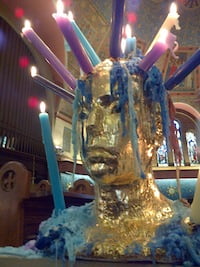
I’ve always wanted to go into St. Anne’s Church, tucked away on Gladstone Ave, just north of Dundas St. West, but not to feed religious urges, more out of art historical interest: the Anglican church, Canada’s only Byzantine-style edifice, is home to a series of religious paintings created by the Group of Seven. This past week, I got my excuse: Mirabilia, a nine-day festival of visual art, music, film, and lectures on religion and the arts, held to commemorate the Church’s 150th anniversary.
Though the program includes several lectures and concerts, it was the art installations (and the Group of Seven works) that appealed most. When I stopped by this past Tuesday, an enthusiastic attendant handed me a map and ushered me through the door, the rushed over to turn on one of the art pieces – an enormous, black and white tentacled form made of vinyl that pushed air through a series of home-made woodwinds, resulting in a pipe-organ of sorts (Max Streicher & Garnet Willis’s “Tree Organ”). This was one of twelve installations by members of the NetherMind Artist’s Collective. This group of eight sculptors were active in the early 1990s exhibiting in industrial spaces, and as evidenced in the twelves pieces installed at St. Anne’s, their work is highly experiential in nature, appealing not only visually but through smell, sound, and touch.
The strongest pieces were those that played with the space. Mary Cahterine Newcomb’s “Osiris’ Advance (10,000 Soldiers), an installation of upright wheat that took over a large portion of the central pews echoed the stalks of wheat embroidered onto the altar cover, and gave off a strong aroma of ripe wheat. Stunning. Catherine heard’s installation “Votive”, featured two gilded busts, covered in candles, graced either side of the altar like living votives, dripping wax onto open-eyed faces. In the basement of the church, a quartet of white horses inflate and deflate – Max Streicher’s “Quadriga” – seeming to menace and then shy away from the viewer. Occupying a small nook off to one side of the cavernous central space, “Hanna’s Cabinet”, by Reinhard Reitzenstein, plays with the olfactory associations of mass – as the viewer entered the space, examining spiritual objects from a host of faiths placed along a high shelf, they tread potpourri, the scent wafting up and filling the small space with a dusty incense smell.
In a space as imposing and grand as St. Annes, these interventions offer a subtle, playful, and uplifting homage to their host. Site-specific installations are fleeting, and this exhibition closes on Sunday. Make the pilgrimage.

One response to “Mirabilia: A Miracle on Gladstone Avenue”
Thank you, Medeine!
A quick correction – the NetherMind Miribilia exhibition closes on Saturday October 20th.
I also invite your readers to my solo exhibition at Edward Day Gallery (until Nov. 3) – http://www.edwarddaygallery.com/exhibitions.htm